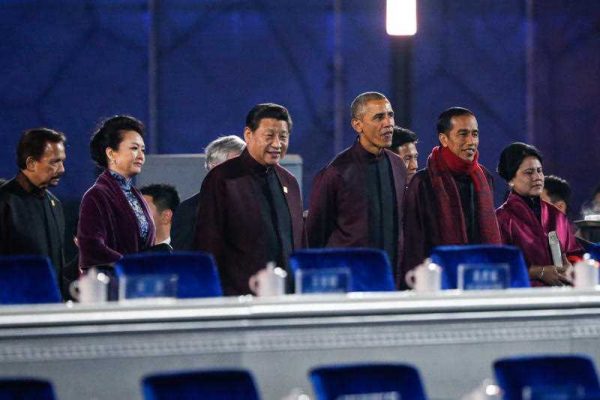China also reached a substantive agreement with South Korea on their bilateral FTA and a breakthrough on negotiations with the Americans to expand the coverage of the Information Technology Agreement — which promises to re-energise a US$1 trillion market in technology goods trade.
But why did China choose FTAAP as its landmark initiative for the APEC summit? The FTAAP concept was first developed by the Americans, so why did China borrow it to stake a leadership claim in defining the future of Asia Pacific economic integration?
At least three motivations seem plausible.
First, to make a big splash in defining the trade agenda by pursuing the most ambitious goal of all: an Asia Pacific trade grouping incorporating both China and the US. Second, to prevent the Trans Pacific Partnership (TPP) from becoming the focal point of economic integration efforts and a reaffirmation of America’s leadership as a Pacific power. And third, for China to carve a much more proactive role in drafting the new rules of the economic order — from a position of equal standing with the United States. Potential entry into the TPP, after it enters into force, would not award China these advantages: China would have to abide by disciplines negotiated by others and would have to make significant concessions to ensure its accession.
Does China’s spate of trade initiatives at APEC augur the emergence of a Chinese-led international economic order? Not yet, as China’s trade diplomacy is reactive, not revisionist. China has moved defensively, agreeing for example to Japan’s longs standing proposal to negotiate a trade agreement among the ASEAN+6 countries (today’s RCEP), out of concern with Japan’s TPP accession. Moreover, China’s endorsement of FTAAP meets a core American national interest: that no lines will be drawn in the middle of the Pacific.
But make no mistake that China is seeking more influence in international economic affairs to match its ranking in global GDP. As China seeks a greater role in the management of the global economy, closer scrutiny of its leadership capabilities will ensue.
In particular, two questions loom large regarding China’s potential to build an alternative trade regime. First, can China become a focal point for economic integration? The preeminent role of China in Asia’s trade flows (as the top trading partner for many countries in the region) is widely known. But a lot of this is trade in components, with China still making a modest contribution to the value added of a final product consumed elsewhere. The key question is whether China can rebalance its growth strategy towards domestic demand and develop lead firms capable of generating their own supply chains in the region. Can China evolve from its position as a central cog in global supply chains, to become — in its own right — the lead economy for the region?
Second, can China offer a distinctive solution to the challenge of deep integration? Supply chain trade has put a premium on negotiating behind-the-border rules to ensure property rights and improve the business climate: service liberalisation, competition policy, regulatory transparency, and the like. But many developing countries have resisted the WTO+ agenda as encroaching on their policy space.
Can China offer a way out of this impasse? Negotiating a run-of-the-mill trade agreement (with rampant exclusions and thin on rules) will generate political gains for China (never to be dismissed), but will not yield an effective architecture to meet the institutional demands of the dominant driver of international trade: supply chains. What then is China’s vision for a twenty-first century trade regime?
Answers to these questions will be of paramount importance. The APEC summit meeting underscored that China’s views cannot be ignored, they need to be accommodated. Hence, the leaders’ statement delivered a carefully calibrated compromise agreeing to the realisation of FTAAP as early as possible (advocated by China), but only after the completion of ongoing pathways (code for TPP) at US insistence.
The United States effectively eliminated any reference to a specific timeline for FTAAP conclusion, but China managed to secure the launch of a collective strategic study on issues pertaining to FTAAP’s realisation. It remains to be seen whether this compromise will hold in the long run. Beijing’s roadmap for FTAAP (included as an annex in the leaders’ statement) blurs the issue of timing by stating that the early realisation of FTAAP should build on ongoing regional undertakings (not making their successful conclusion a prerequisite).
With the absence of a breakthrough in US–Japan market access negotiations, the statement from TPP leaders gathering on the sidelines of the APEC meeting was much more subdued, noting only that the ’end is coming into focus’. This is the greatest irony behind the inability of the United States and Japan to reach a deal: as time runs out to deliver a timely success on TPP they are letting China win by default.
Mireya Solís is Philip Knight Chair in Japan Studies and Senior Fellow, Center for East Asia Policy Studies at the Brookings Institution.


Mireya is spot on with her assessment of this. My own view is that concluding any of these regional FTAs – the TPP, RCEP and FTAAP – is probably some way off, and there is a chance I think that the TPP will fail to be concluded, just like the Free Trade Area of the Americas around a decade previously. The US, or rather US Congress, is just not flexible enough to make the compromises required to conclude a trade deal that incorporates such an ambitious a commercial regulatory agenda with such a diverse set of countries